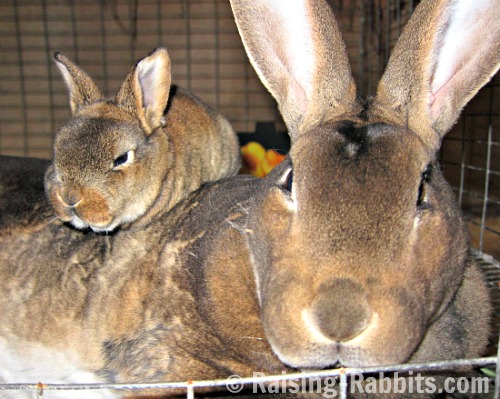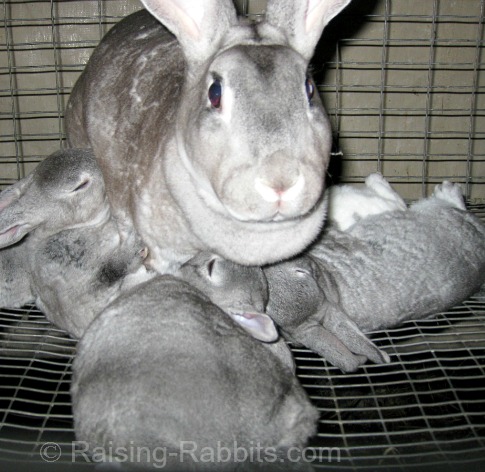Weaning Rabbits
Weaning Rabbits How To’s – How and when to wean, physiological versus physical weaning, and reducing the risk of stress-induced diarrhea after weaning baby bunny rabbits.
Weaning is best done as a process rather than an event. As a general guideline, 5.5 - 6 weeks old is a fine age for beginning the weaning process.
Physiological Weaning vs Physical Weaning
Thanks to natural instincts and capabilities within the genetic DNA of the rabbit, rabbit kits are fully able to feed themselves by 28 days of life (4 weeks). This coincides with the doe’s ability to bear another litter 31 days after the prior litter’s birth.
In domestic rabbits, kits’ milk intake is at its maximum at around 3 weeks of age and it tapers off between 4 weeks and 7 weeks. We call this physiological weaning.
Physiological weaning takes place long before physical weaning does, most of the time.
We know that rabbits in the wild physically wean their litters at 4 weeks of age or slightly earlier. This is because they are already very pregnant with their next litter and they simply abandon the 4-week-old kits in order to go off and dig themselves a new burrow. In this case, physiological weaning and physical weaning are concurrent.
At 4 weeks of age, all baby rabbits are more or less physiologically weaned at 4 weeks old, including our domestic rabbits, meaning they are eating and drinking on their own, and getting most or all of their sustenance by feeding themselves.
In modern rabbitries, however,
the wise breeder has significant control over which animals breed when. Therefore in rabbitries today, does are typically not re-bred until the
prior litter has been physically weaned, or even later. Therefore, the doe may not feel the innate, physiological imperative to drive her bunnies away from
her. This is why we typically see does allowing their kits to continue nursing
well into week 6 or 7, if the doe is allowed to remain with her kits that long.
It's not that the kits aren't physiologically weaned, it is that the doe feels
magnanimous toward her kits (if one can attribute altruism to a rabbit!) and
doesn't mind them snacking at the milk bar now and again.
(The same behavior occurs in the wild as well - the doe remains with the last litter of the breeding season and allows them to nurse for much longer because she has no more kits 'in the oven,' and won't rebreed for several months.)
Physical Weaning: At
some point between 5-7 weeks is when the dam is physically separated from the
kits, resulting in actual (physical) weaning.
STRESS at Weaning Rabbits
There's no way to avoid stress at weaning entirely. Weaning causes some degree of stress. Bunnies subjected to too many stressful situations within too short a time are the bunnies most at risk for enterotoxemia - diarrhea - shortly after being weaned.
STRESS is what threatens a weanling's health, not the act of weaning per se.
- We know that weaning is stressful on a bunny,
especially if you remove the youngster from his cage, dam, and littermates
all at one time and put it in its own unfamiliar cage.
- In some bunnies, that stress is compounded if you
immediately add to all that the unfamiliar or noisy surroundings of a
brand new location such as a new owner or a pet shop.
- We know that stress can cause or exacerbate a dangerous
imbalance within the guts of bunnies whose intestinal flora is still
immature (dysbiosis). If stress-induced diarrhea is going to develop, it will likely
take a few days to a week to appear.
- We also know, however, that bunnies can die from enterotoxemia
well before weaning, and in fact at any point throughout their lives. Clearly, weaning isn't a direct cause of
enterotoxemia, but rather a source of stress.
- One other observation - if a new rabbit owner purchases a newly weaned baby rabbit, and then feeds it sugary stuff like apples and bananas and doesn't provide fiber such as grass hay, I can almost promise you a case of diarrhea. But it will have nothing to do with weaning rabbits and everything to do with too many sweets in the diet.
Weaning by itself doesn't cause diarrhea. It causes stress. (It's got to also be stressful to the
wild little month-old baby rabbits in the wild.)
But what if you could reduce the overall stress by weaning your bunnies in little increments over a period of several days?
Bunnies can handle little stresses if the stresses occur one at a time.
Sherwood Pet Health Rabbit Feeds: the Best Karen Has Found...
Weaning Rabbits: A Week-Long Process rather than an Event
 This 2 1/2 week old kit is unweaned. Its sibling died from enterotoxemia due to dysbiosis the day before this picture was taken.
This 2 1/2 week old kit is unweaned. Its sibling died from enterotoxemia due to dysbiosis the day before this picture was taken.The following steps could be considered a good example of a weaning process, understanding that each rabbitry will present slightly different circumstances and utilize a slightly different protocol for their various litters.
Various iterations of the following ideas have been effective at Aurora Rex Rabbits, but don't think you must follow this schedule rigidly. Consider it an example of how one can separate stressors to the weanling bunnies and help ensure a successful weaning process:
- We give our kits a bit longer than 4 weeks before
starting the weaning process. They might be anywhere between 5 - 7 weeks
old.
- Remove the dam to a new cage, leaving the kits in their
familiar home. This mimics Nature, where the dam simply abandons the kits to fend for themselves so she can go dig another burrow and give birth to her next litter.
- If necessary, send the 1-2 smallest kits with her, for two reasons. First, the small kits will get 8 teats all to themselves, providing one last shot at full bellies before being weaned.
Second, their suckling will help relieve the glut of milk that may result from weaning. If the kits are already 6-7 weeks old, this will probably not be an issue as the doe will already be limiting access to the milk bar. - In 1-2 days, return these kits to their littermates.
- Wait another day or two before making any further
changes. This means that most of the kits are now 2-4 days removed from their
dam.
- Any kits already sold could go into separate cages for
a final 2-4 days.
- Kits remaining in the rabbitry can be separated
according to gender after an additional few days.
- Each kit should get its own cage eventually, by 9-11
weeks of age at the latest.
In this fashion, the stress from weaning rabbits is broken into 4-5 stages that stretch over a week's time or sometimes longer.
When these kits go to their new homes, the move will no doubt trigger some stress, but not utter terror.
When weaning rabbits, there is no way to totally eliminate the stress to the bunnies. But by breaking the stressful season into steps, the breeder can reduce or minimize the risk of stress-induced catastrophic diarrhea.
Double-Value Guarantee
Our policy is to always OVER-deliver
on value,
which is why your purchase is fully covered by our
Double-Value
Guarantee.
Go ahead - take any of our e-books for a test drive. Peruse our detailed informational and educational e-books. Examine our plans for building rabbit cages, runs, or metal or PVC hutch frames. Check out the Rabbit Husbandry info e-books.
If you aren't completely satisfied that your e-book purchase is worth at least double, triple or even quadruple the price you paid, just drop us a note within 45 days, and we'll refund you the entire cost. That's our Double-Value Guarantee.
Note: When you purchase your
e-books, they will be in PDF format, so you can download them to any device that
supports PDF format. We advise making a back-up copy to a drive or cloud
account. If the books are lost, you can also purchase another copy from Raising-Rabbits.











New! Comments
Have your say about what you just read! Leave me a comment in the box below.